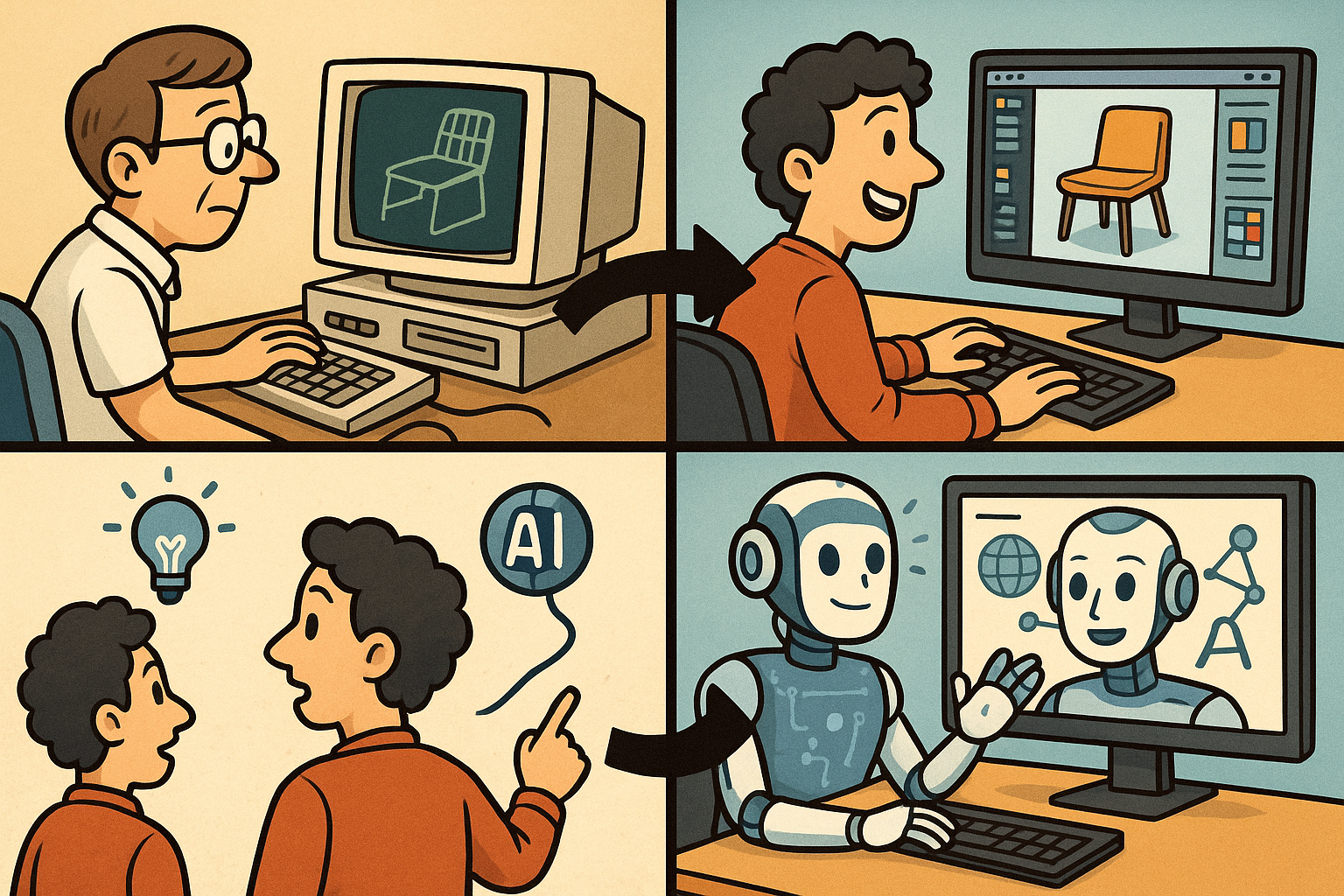Your Cart is Empty
Customer Testimonials
-
"Great customer service. The folks at Novedge were super helpful in navigating a somewhat complicated order including software upgrades and serial numbers in various stages of inactivity. They were friendly and helpful throughout the process.."
Ruben Ruckmark
"Quick & very helpful. We have been using Novedge for years and are very happy with their quick service when we need to make a purchase and excellent support resolving any issues."
Will Woodson
"Scott is the best. He reminds me about subscriptions dates, guides me in the correct direction for updates. He always responds promptly to me. He is literally the reason I continue to work with Novedge and will do so in the future."
Edward Mchugh
"Calvin Lok is “the man”. After my purchase of Sketchup 2021, he called me and provided step-by-step instructions to ease me through difficulties I was having with the setup of my new software."
Mike Borzage
Design Software History: Historical Evolution and Impact of AI in Design Software: From Early CAD Limitations to Modern Intelligent Solutions
May 18, 2025 10 min read


Historical Context and The Emergence of AI in Design Software
The early days of design software were characterized by revolutionary digital tools that emerged to meet the growing demands of the engineering and architectural communities. At this juncture, the software was primarily focused on computer-aided design (CAD) and computer-aided manufacturing (CAM) with significant limitations. Early systems were confined by the computational power available at the time and were reliant on relatively primitive algorithms for rendering geometric models and simulating design prototypes. These programs made use of simple geometric representations and largely lacked the capability to handle complex engineering computations or advanced visualizations. In addition, many algorithms were based on fundamental mathematical models that could only process linear or quadratic equations, making them cumbersome when addressing non-linear or real-world scenarios.
Early Limitations and Challenges
It is important to note that designers faced numerous hurdles such as limited memory, slow processing speeds, and rudimentary user interfaces which hindered the broader application of these systems. The limitations of early design software can be summarized with the following points:
- Restricted computational capabilities: Early computers could not process complex models efficiently.
- Basic geometrical algorithms: Many systems relied on simple algorithms that were inadequate for advanced simulations.
- Primitive user interfaces: The interfaces offered little in terms of usability or interactive design assistance.
Technological Environment and the Emergence of AI Concepts
As computing technology advanced throughout the late 20th century, the technological environment became fertile ground for artificial intelligence research and its integration into design software. A wide range of research initiatives began to explore machine learning, neural networks, and evolutionary algorithms that aimed to solve problems in optimization, pattern recognition, and prediction – all of which were directly applicable to design processes. Traditional design software was largely deterministic, but AI’s probabilistic models showed promise in overcoming the limitations of standard approaches. The infusion of AI enabled systems to learn from vast amounts of data and adapt their operations based on accumulated design knowledge. This was especially beneficial for addressing design inefficiencies, optimizing spatial layouts, and enhancing product visualization by providing dynamic, flexible computational models that could deal with greater levels of complexity.
Advances in Hardware and Software Integration
The combination of improved processing power, increased memory capacities, and the emergence of advanced programming models allowed for the development of software that could truly harness AI-driven approaches. During this period, several key factors contributed to the rise of such technologies:
- Enhanced processing power: This enabled designers to implement more complex algorithms and perform advanced simulations in real time.
- Algorithmic breakthroughs: Developments in neural networks and machine learning provided the theoretical underpinning for more intelligent design applications.
- Data availability: The growth in data capture and storage capacities meant that vast datasets could be analyzed to inform design decisions.
Pioneers and Early Integrations
The integration of AI into design software during its nascent stage was driven by a diverse range of innovators, research laboratories, and companies that were eager to push the boundaries of what technology could achieve. Individuals and institutions around the globe began experimenting with blending AI algorithms with CAD, CAM, and related design tools. Notable pioneers were drawn from academic settings as well as government-funded research projects that explored computational intelligence, aiming to automate and streamline conventional design processes. The interdisciplinary research spearheaded by these early adopters combined insights from mathematics, computer science, and engineering to create prototypes that could handle tasks such as design optimization, pattern recognition, and spatial configuration.
Key Players and Their Contributions
Among the early integrators, several key figures and organizations emerged as landmarks in the journey toward AI-driven design. Some of the most relevant key phrases in their work include adaptive algorithms, machine learning models, and heuristic optimizations. These pioneers typically operated within an environment that encouraged experimentation. Their contributions can be encapsulated by the following points:
- Innovative research labs: Facilities in academic institutions and government centers made it possible to investigate unconventional methods in computational design.
- Early prototypes: Experimental software was developed that provided functional demos of AI capabilities in design tasks.
- Interdisciplinary approaches: Combining fields such as artificial intelligence, computational biology, and engineering to create comprehensive design tools.
Notable Innovations and Research Contributions
While the early integration of AI into design software featured a wide array of projects, several innovations stand out for their impactful contributions. Researchers devised exploratory systems that could learn from past design data to automatically generate design alternatives. These systems were typically devised as modules within larger CAD environments and provided the designer with a spectrum of choices for finalizing a design. Some experiments focused on optimizing product dimensions and material usage using genetic algorithms, while others employed rule-based expert systems to suggest design modifications. Encouraged by these preliminary successes, research labs across different regions adopted these innovative approaches to develop more comprehensive AI systems. The integration process was methodical, relying on basic heuristics initially before advancing into more sophisticated methodologies such as neural networks and deep learning algorithms.
Breakthroughs in Computational Design Methods
A number of computational breakthroughs further accelerated these developments within early design software. These breakthroughs included:
- Genetic algorithms for optimization: Early experiments utilized evolutionary strategies to iteratively refine design parameters.
- Rule-based systems: These systems embedded expert knowledge to guide automated design modifications.
- Neural network applications: Initial forms of machine learning were employed to identify recurring design patterns and suggest improvements.
Modern AI-Driven Design Software and Its Impact
In contemporary design environments, AI-driven software has achieved remarkable milestones by transforming both the creative and analytical aspects of design. Today’s leading design companies integrate sophisticated AI algorithms that offer unparalleled optimization, automation, and creative assistance capabilities. This advancement enables designers to generate variations of models in record time, optimize complex engineering calculations, and enhance product visualizations with high fidelity. As a result, modern design processes have become significantly more efficient, adaptable, and innovative. Advanced techniques such as deep learning, generative design, and simulation-based optimization have become central features in platforms offered by industry giants like Autodesk and Dassault Systèmes. These platforms integrate AI seamlessly with traditional design paradigms to produce enhanced user interfaces, reducing manual intervention and allowing designers to focus on complex problem-solving and creativity.
Contemporary Tools and Their Advanced Features
Modern design tools also benefit from vast improvements in data processing and computational power, which allow for the execution of highly complex simulations and optimizations. Key features include:
- Automated design iterations: Systems generate multiple design alternatives based on predefined constraints, significantly shortening development cycles.
- Optimization algorithms: Advanced algorithms efficiently utilize resources, providing cost-effective and robust solutions.
- Enhanced visualization and simulation: Detailed simulations and high-resolution product visualizations enable better decision making.
Reshaping Workflows and Design Methodologies
The influence of AI on modern design workflows is profound, extending into nearly every facet of the design process—from initial concepts to final product development. Engineers and designers benefit from AI tools that are now able to capture design intent, suggest iterative improvements, and even predict project outcomes with impressive accuracy. These developments have altered traditional methodologies by infusing intelligent automation into areas such as product visualization, material optimization, and performance simulation. As a result, the overall design cycle has become more iterative and dynamic, reducing the gap between conceptual design and executable models. The shift towards an AI-driven process has necessitated not only technical adjustments but also changes in how organizations structure their teams and workflows. The simplicity of manual adjustments and trial-and-error approaches is gradually giving way to data-informed decisions and predictive analytics, thus helping designers focus more on strategic and creative challenges.
Key Benefits and Workflow Enhancements
Some of the most compelling benefits of modern AI-driven design include:
- Streamlined collaboration: Cloud-based environments enable teams worldwide to collaborate in real time, reducing development time and improving project outcomes.
- Data-driven decisions: AI algorithms analyze extensive datasets to provide actionable insights that enhance design quality.
- Adaptive design processes: Continuous learning models adapt to shifting project parameters and market trends, ensuring designs remain competitive and cutting-edge.
Conclusion: Reflections and Future Directions
Reflecting on the evolution of AI in design software reveals a transformative journey that began with rudimentary CAD tools and evolved into sophisticated platforms that seamlessly integrate artificial intelligence. The journey from early computational challenges to the modern era of advanced algorithms underlines how critical innovations in hardware, software, and interdisciplinary collaboration have revolutionized the design process. The evolution is marked by a steady transition towards more adaptive, data-driven systems that not only automate routine tasks but also expand creative boundaries. Designers today benefit from efficiency, cost reduction, and enhanced visualization capabilities, all of which have been made possible by the continuous infusion of AI technologies into everyday workflows.
Reflections on the Impact of AI on Design Efficiency
The impact of AI in design software is evident in the significant improvements in workflow efficiency and product innovation. Over the past few decades, the fusion of machine learning techniques with traditional design paradigms has enabled breakthrough advances in optimization and simulation. Design teams now operate with the support of systems that continuously learn and adapt to real-world constraints, delivering improved performance and innovative solutions. The role of key innovators and pioneering institutions has been pivotal in this evolution. As the lines between human creativity and artificial intelligence blur, the design process is transforming into a more collaborative, dynamic, and forward-thinking discipline. With benefits such as automated iteration, data-driven decision-making, and enhanced product visualization, the adoption of AI has not only redefined design efficiency but has also fostered a culture of continuous improvement and creative risk-taking.
Speculations on Future Breakthroughs in AI-Driven Design
Looking forward, the path for AI-driven design software appears vibrant and filled with possibilities. The future holds tremendous promise for even deeper integration of AI into all aspects of design, ranging from early concept generation to large-scale simulations and lifecycle management. As computational power continues to increase and algorithms become more sophisticated, future developments may include fully autonomous design systems capable of producing optimal solutions without human intervention. These systems are likely to harness cutting-edge technologies such as quantum computing, augmented reality (AR), and advanced neural networks to push the envelope of what is possible in design. With these advances, design management will become more proactive, leveraging predictive analytics to iterate designs in real time and adapt to changing market demands or environmental considerations.
Considerations for Continuous Adaptation and Research
As developers explore these exciting frontiers, several key trends are poised to define the next era of AI-driven design:
- Quantum computing integration: Potential breakthroughs in processing capabilities could drastically reduce simulation times and improve design precision.
- Enhanced generative design: Sophisticated AI models may evolve into systems that generate complex design solutions from simple conceptual frameworks.
- Augmented reality applications: Real-time visualizations combined with AI insights will allow designers to see changes and improvements as they occur, bridging the gap between digital and physical prototypes.
Also in Design News

Design Software History: Foundations of Material Property Modeling in Early Design Software: Pioneers, Techniques, and Their Impact on Modern Engineering Practices
May 19, 2025 8 min read
Read More
Bluebeam Tip: Enhance Workflow Efficiency by Converting Scanned PDFs to Editable Text with OCR in Bluebeam Revu
May 19, 2025 1 min read
Read More
Cinema 4D Tip: Mastering the Field Force Object for Advanced Simulations in Cinema 4D
May 19, 2025 2 min read
Read MoreSubscribe
Sign up to get the latest on sales, new releases and more …


